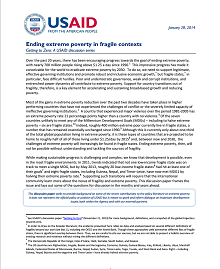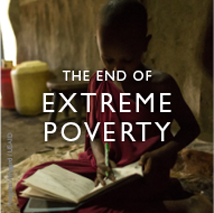- What We Do
- Agriculture and Food Security
- Democracy, Human Rights and Governance
- Economic Growth and Trade
- Education
- Ending Extreme Poverty
- Environment and Global Climate Change
- Gender Equality and Women's Empowerment
- Global Health
- Water and Sanitation
- Working in Crises and Conflict
- U.S. Global Development Lab
A discussion paper on ending extreme poverty in fragile contexts
January 28, 2014
Over the past 20 years, there has been encouraging progress towards the goal of ending extreme poverty, with nearly 700 million people rising above $1.25 a day since 1990. This impressive progress has made it conceivable for the world to eradicate extreme poverty by 2030. To do so, we need to support legitimate, effective governing institutions and promote robust and inclusive economic growth, but fragile states in particular, face difficult hurdles. Poor and undemocratic governance, weak and corrupt institutions, and entrenched power dynamics all contribute to extreme poverty. Support for country transitions out of fragility, therefore, is a key element for accelerating and sustaining broad-based growth and reducing poverty. Most of the gains in extreme poverty reduction over the past two decades have taken place in higher performing countries that have not experienced the challenges of conflict or the severely limited capacity of ineffective governing institutions.
A country that experienced major violence over the period 1981-2005 has an extreme poverty rate 21 percentage points higher than a country with no violence. Of the seven countries unlikely to meet any of the Millennium Development Goals (MDGs) – including to halve extreme poverty – six are fragile states. Indeed, roughly 400 million extreme poor currently live in fragile states, a number that has remained essentially unchanged since 1990. Although this is currently only about one-third of the total global population living in extreme poverty, it is these types of countries that are projected to be home to roughly half of all of those living under $1.25/day by 2015 and, between now and 2030, the challenges of extreme poverty will increasingly be found in fragile states. Ending extreme poverty, then, will not be possible without understanding and tackling the sources of fragility. While making sustainable progress is challenging and complex, we know that development is possible, even in the most fragile environments. In 2011, trends indicated that not one low-income fragile state was on track to meet a single MDG, but by May 2013, roughly 20 low-income fragile states had hit at least one of their goals and eight fragile states, including Guinea, Nepal, and Timor-Leste, have now met MDG1 by halving their extreme poverty rate.
Supporting such transitions will require that the international community learn more about the nexus of fragility and extreme poverty. This discussion paper frames the issue and lays out some of the questions for discussion in the months and years ahead.
Read the full discussion paper: Getting to Zero - Ending Extreme Poverty in Fragile Contexts
This discussion paper does not represent the official policy or position of USAID. It is meant to spark and inform dialogue on important development issues, within the Agency and with our external partners.









Comment
Make a general inquiry or suggest an improvement.